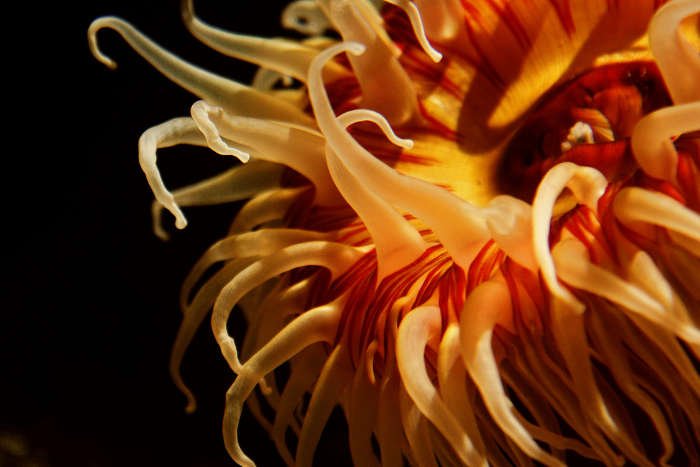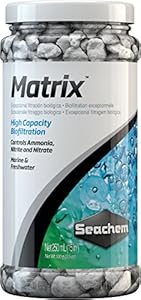Biological filtration has always been a major topic for discussion with freshwater and marine aquarists.
Biological filtration is a very general term relating to water purification performed by bacteria. Most aquarists think of ammonia and nitrite removal when biological filtration is mentioned. Reef enthusiasts include biological nitrate reduction in the discussion.

(source)
Biological filtration media is a type of filter media designed to provide a place for the bacteria to settle on and form stable colonies.
Before we review different biological filter media, let’s take a closer look at the microbes that make biological filtration happen in our aquariums.
Bacteria and biological filtration
There are hundreds of kinds of aquatic micro-organisms living in our aquariums. They filter out debris, break down organic substances and recycle nutrients.
When we discuss aquarium biological filtration we are mainly concerned with the “removal” of ammonia (NH3) and nitrite (NO2–). The process is a biochemical transformation of harmful ammonia to nitrite and then nitrite to nitrate (NO3–).
This two-step transformation is achieved through two types of bacteria. The first type of bacteria convert ammonia to nitrite, which is also toxic to aquatic life.
A second type of bacteria convert nitrite to relatively harmless nitrate. The bacteria use these substances as an energy source. The transformation of toxic ammonia and nitrite to nitrate is a byproduct of the bacteria’s metabolism.
These bacteria are called “nitrifying” bacteria because the process of converting ammonia to nitrate is called “nitrification”.
A third type of bacteria convert nitrate to into nitrogen gas. This bacteria-driven process is called denitrification. Denitrification and reducing nitrate levels is especially important to reef aquarists who keep corals.
The truth about bacteria and biological filtration
A lot of old information still circulates among aquarists and the internet concerning the bacteria that perform biological filtration. Current research about nitrifying bacteria has replaced most of the traditional thinking about nitrification in aquariums but “fish lore” lives on for decades on the internet.
Let’s look at some of the new facts about nitrifying bacteria through a Question and Answer session.
Nitrifying bacteria will die if there is not enough oxygen.
False. Nitrifying bacteria remain alive and active even in low oxygen conditions. This is how they survive in nature, where oxygen levels rise and fall every day.
The biological filter in an aquarium needs lots of oxygen and aeration to help the bacteria get rid of ammonia and nitrite.
False. Normal water movement and aeration provides enough oxygen for the biological filter. Excessive aeration is unnecessary.
Saltwater aquariums contain different bacteria than freshwater tanks
Mostly true. Some species of nitrifying bacteria are found only in fresh or saltwater. But there are some nitrifying bacteria that live equally well in both types of aquariums.
Nitrifying bacteria live only solid surfaces like biological filter media.
False. Nitrifying bacteria live in the water but also form colonies on solid surfaces in the aquarium.
Denitrifying bacteria require low oxygen conditions to remove nitrate.
The truth is nitrifying bacteria will grow on just about any surface they can in your aquarium.
The “biological filter” is not in one place, like a power filter. It is spread out in the water, on the glass, gravel, live rock, plants and biological filter media.
If this is true, why do we need biofilter media? We’ll cover that next!
Why do I need special biofilter media?
As we’ve discussed bacteria will find their “home” throughout your aquarium. They’ll spread out everywhere, reproduce and form colonies.
Imagine if you tried to build a house on a rocky coast that was constantly buffeted by abrasive waves. What if your neighborhood was periodically demolished by a mudslide?
How about if a tornado flipped your home once a month?
Doesn’t sound like a nice location to settle down, does it? It’s the same for the bacteria in the aquarium.
Gravel cleaning, glass scraping, washing plastic plants, water changes and anything else that disturbs the bacterial balance can reduce the effectiveness of the “biological filter” inside the aquarium.
Biofilter media are intended to provide a safe and stable environment for the bacteria, no matter what happens in the rest of the aquarium.
The bacteria colonies living in and on the biofilter media act as a nitrifying bacteria farm, releasing a steady supply of new beneficial bacteria to recolonize the entire aquarium.
- If you have tanks that hold high numbers of fish, like feeder goldfish, biofilter media really helps maintain low ammonia and nitrite levels.
- Large cichlids, goldfish and koi eat a lot of food and release substantial amounts of ammonia. Extra biofilter media can help provide a more stable biological filter.
- Reef aquariums containing live rock only need biofiltration media designed for denitrification.
- Reef aquariums containing live rock only need biofiltration media designed for denitrification.
- Natural planted aquariums typically have low levels of fish and do not require a lot of biofilter media.
What order do I use biofilter media in my filter?
Most types of biofilter material redirect the water flow to pass through a bed or chamber of media.
Suspended organic matter, uneaten fish food and solid fish waste will settle in the biofilter media because of the slower water velocity in the bed of biological media.
The heavier particles will settle in and on top of the biofilter media. For example, if you load your canister filter so incoming water first passes through the bio media, the media will act as a coarse mechanical filter and collect sludge and debris.
The accumulated organics tend to stimulate the growth of fast-growing non-nitrifying bacteria. These bacteria grow very quickly and can crowd out the beneficial nitrifying bacteria.
The best location for biofilter media is in the cleanest part of the filter system.
Use prefilter media like sponge pads to remove solids before the water flows through the bio media. You can rinse or replace the prefilter media and leave the bacteria on the biofilter media undisturbed.
How much biofilter media do I need?
Not every manufacturer provides instructions on how much to use per gallon. This may be because biofilter media is often pre-packaged for a specific filter.
The truth is there is no exact scientific formula for aquarium biofiltration media calculation.
Every aquarium is different in regards to fish and invertebrate size, number and amount of food added by the aquarist.
Nitrate reduction is similar. If a manufacturer recommends a certain use rate, try that first. More media can be added later if necessary.
What type of biofilter media should I use?
There are many types of biofilter media. Most are made from plastic, natural minerals or man-made ceramic materials.
Let’s take a look at each media and learn how to select and use them in your aquarium.
Recommended Biofilter Media Reviews
1. Fluval BioMax Bio Rings
Fluval BIOMAX bio rings are composed of silica and aluminum oxide formed into a porous ring.
The internal pore system provides a surface for nitrifying and denitrifying bacteria to colonize.
As pores capture debris a natural balance of ammonia, nitrite and nitrate removal occurs.
BIOMAX bio rings have more capacity than smooth biological filter media.
The rings have a hole in the center that allows water movement throughout the media to ensure optimal contact time for efficient biological filtration.
Pros
- Inexpensive.
- Allows denitrification.
- Suitable for all aquariums.
Cons
- Manufacturer recommends replacing some media every six months.
2. Fluval Bio Foam
The foam acts as a prefilter, capturing fine debris.
There is a lot of surface area in the foam for nitrifying bacteria too.
Saltwater can make some foams brittle.
Pros
- Custom-fit for Fluval filters.
- High surface area.
- Inexpensive.
- Easy to clean.
Cons
- Can become clogged and reduce flow rate.
- Cleaning disturbs the bacteria.
3. Seachem Matrix
The surface of the Matrix media provides a rough surface for bacterial attachment.
One liter of Matrix™ provides as much surface area (>700 square meters) as 170 liters of plastic balls, according to the manufacturer.
Matrix provides both external and internal “macroporous” surface area.
The macropores are large enough for nitrifying and denitrifying bacteria to get inside. This feature, unlike other non-porous biomedia, allows bacteria to remove nitrate along with ammonia and nitrite at the same time.
Use one 250 ml jar for up to 25 US gallons of aquarium water.
Pros
- Removes nitrate, nitrite and ammonia.
Cons
- May need to use larger Pond Matrix in drip tray systems.
4. Eheim Substrat Pro
Substrat Pro is a German biofilter material.
Eheim took this technology and created a sintered bead for biological filtration in aquariums.
Best for freshwater and marine fish aquariums.
Pros
- Inert glass does not break down in the aquarium.
- Removes nitrate, nitrite and ammonia.
- Compatible with freshwater and marine aquariums.
Cons
- Expensive.
5. CerMedia MarinePure
CerMedia is a manufacturer of porous ceramic materials for industrial wastewater treatment.
The kiln-fired ceramic material has a rough surface and large porous structure.
CerMedia created a round media for aquariums, called MarinePure.
The ceramic is inert and won’t change pH or release anything into the aquarium water. Unlike closed-pore biomedia, water can freely flow through the porous ceramic.
The best way to use MarinePure would be in a canister filter or contact chamber.
Reef aquarists will appreciate the biological nitrate-reducing properties that the media promotes.
Planted aquariums reduce nitrate through plant growth and would not really benefit from this style of biofilter media.
Pros
- Open pores allow water to pass through the media.
- Strong ceramic that does not physically break down.
- Great for reef aquariums that require nitrate reduction.
Cons
- Spheres are larger than most media and take up space.
- Very expensive.
6. Marineland Biofilter Balls
Biofilter balls are traditional non-porous plastic “bio balls”.
Water flows freely over and through the balls. There are no pores to trap debris and support denitrifying bacteria.
This is the perfect media for freshwater aquariums and planted aquariums with a canister filter.
The media never needs replacing.
Pros
- Simple biomedia that never gets dirty, or needs replacing.
- Inexpensive.
- Effective.
- Ideal for freshwater aquariums and fish-only saltwater tanks.
Cons
- Does not have nitrate-removing capacity.
7. Bio-Chem Stars
The plastic has a porous surface along with interconnecting channels throughout the star structure.
This pore structure will promote stable colonies for biological ammonia, nitrite and nitrate reduction.
The biomedia floats at the water surface.
The floating biomedia stay near the surface and above other media like sponges and activated carbon. Only two Stars are need per ten gallons of water.
Pros
- Made specifically for nitrifying and denitrifying bacteria.
- Safe, medical grade porous plastic won’t break down.
- Two Stars per gallons.
- Does not take up a lot of room inside the filter.
- 50-70 micron pore network.
Cons
- Could be expensive if you want to fill up a large canister filter.
My Pick
The good news is that all of these biofiltration media work as described.
The main decision points will be the need for nitrate removal, cost and available space in your aquarium’s filter system.
Marineland Biofilter Balls will work well for fish-only and planted aquariums.
Seachem Matrix is an effective and reasonably-priced biofiltration media with nitrate-reducing capability.
Matrix is especially useful in reef aquariums where nitrate removal is highly desirable.
CerMedia MarinePure is expensive but offers a high-porosity flow-through design not found in other biological filter media.
MarinePure is recommended if your reef tank has an on-going nitrate problem.
NavigationBacteria and biological filtrationThe truth about bacteria and biological filtrationWhy do I need special biofilter media?What order do I use biofilter media in my filter?How much biofilter media do I need?What type of biofilter media should I use?Biofilter Media Reviews1. Fluval BioMax Bio Rings2. Fluval Bio Foam3. Seachem Matrix4. Eheim Substrat Pro5. CerMedia MarinePure6. Marineland Biofilter Balls7. Bio-Chem StarsMy Pick








